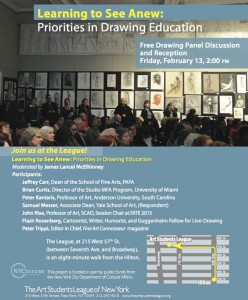Observational drawing is enjoying a revival. Renewed interest in visual expression is fueled by the proliferation of images of artwork on the Internet, the primacy of freehand drawing in the animation and game design industries, and the doggedness of the studio artist who daily measure their vision against a ready surface with burnt sticks. Drawing today is often taught under the heading of works on paper.
Can it be described as a materials-based creative activity, or is it something more?
During the early 19th century Horace Mann described drawing as “an essential industrial skill” and as a “moral force”. John Gadsby Chapman declared, “Anyone that can learn to write can learn to draw”. In his introduction to Graphics, his 1834 textbook for a high school course of drawing and penmanship, Rembrandt Peale compared drawing to handwriting, a basic skill required by an educated citizenry.
Is it appropriate today to continue discussions about issues of style?
How does drawing affect creative practice? What are the most effective ways to promote drawing to improve visual literacy, design, and spatial reasoning?
Dr. Robert Root Bernstein argues that scientists who make art make better science. Pre-college education has abandoned cursive penmanship while a few stalwarts insist that not only is it an essential skill, but also a powerful aide-de-memoire.
During the last few decades programs have emerged, devoted to the mastery of observational drawing; not exclusively to train artists but to provide anyone who values learning with a visual language to decode the forms of nature and design.
What are new priorities in drawing instruction? In the immediate future, what roles are to be played by traditional academic drawing, avant-garde practice; experiment, play and provocation, performance, revisions to foundations curricula, writing in longhand, drawing on computer tablets, animation design, easel painting and artists’ books? How will higher education make the study of drawing more relevant to the post-millennial students? How might its new approaches validate drawing for K12?
Presenters will each identify their top priority for advancing the study of drawing.
LEARNING TO SEE ANEW: PRIORITIES IN DRAWING EDUCATION
PANEL DISCUSSION AT 2:00 PM, FEBRUARY 13, 2014 AT THE ART STUDENTS LEAGUE OF NEW YORK, PHYLLIS HARRIMAN MASON GALLERY, SECOND FLOOR 215 WEST 57TH STREET, NEW YORK NEW YORK 10019
MODERATED BY JAMES LANCEL MCELHINNEY
PARTICIPANTS
JEFFREY CARR, Dean of the School of Fine Arts, PAFA
BRIAN CURTIS, Director of the Studio MFA program, University of Miami
PETER KANIARIS, Professor of Art, Anderson University, South Carolina
SAMUEL MESSER, Associate Dean, Yale School of Art (Respondent)
JOHN RISE, Professor of Art, SCAD, Session Chair at FATE 2015
FLASH ROSENBERG, Cartoonist, Animator, Humorist, and Guggenheim Fellow for Live-Drawing, pioneering Artist in Residence for LIVE from the New York Public Library
PETER TRIPPI, Editor in Chief, FINE ART CONNOISSEUR magazine, President, Association of Historians of Nineteenth Century Art.
